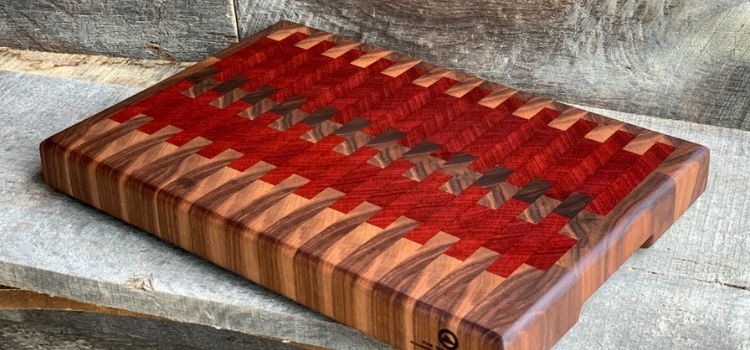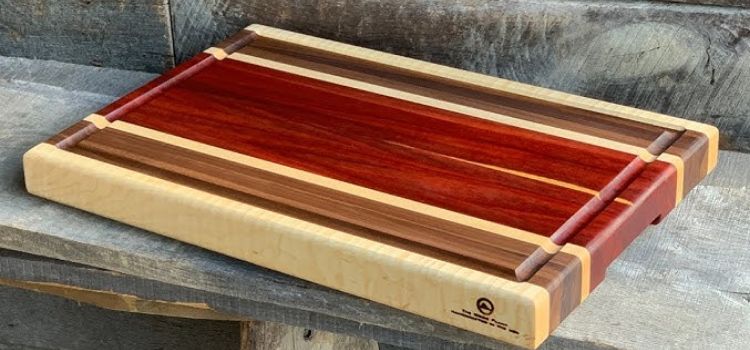As an Amazon Associate, I earn from qualifying purchases

In the vibrant world of kitchen tools, the cutting board stands as an essential companion to every chef, amateur or professional. This everyday tool is not just a chopping surface; it’s a staple that influences the ease of preparation and longevity of knives. With various materials available, the decision on which wood to choose for your cutting board is significant.
Among the more exotic options is zebra wood, known for its striking striped appearance and robust characteristics. This article delves into the properties of zebra wood, compares it with other popular woods like maple and walnut, and evaluates its suitability for cutting boards, thus guiding you in making an informed choice.
Properties of Zebra Wood
Zebra wood, named for its unique zebra-like stripes, is a hardwood sourced primarily from the tropical regions of West Africa. Its eye-catching appearance is not its only asset. Zebra wood is moderately hard, which provides a balance between durability and usability. This wood is strong enough to withstand regular kitchen activities, making it a viable option for cutting boards.
The aesthetic appeal of zebra wood is undeniable. Its bold, contrasting grain patterns can turn a mundane kitchen tool into a centerpiece of kitchen décor. This visual allure makes it a favorite among those seeking something unique and stylish.
However, zebra wood’s characteristics extend beyond mere aesthetics. It’s moderately dense, contributing to its durability without being overly harsh on knives. This density also helps resist wear and tear, although it may not be as forgiving as softer woods. Additionally, like many hardwoods, zebra wood has a low porosity, which helps resist moisture absorption and reduces the risk of bacterial growth—an essential factor for any cutting board material.
Comparison with Other Cutting Board Woods
Choosing a cutting board often involves comparing different types of wood, weighing each for its strengths and weaknesses. Maple and walnut are popular choices, often praised for their balance of durability and knife-friendliness.
Maple, a traditional favorite, is known for its hardness and light color, making it both functional and versatile. It’s hard enough to endure the demands of daily use while being gentle on knife edges. Its subtle grain makes it an adaptable addition to any kitchen style.
Walnut, with its rich, darker appearance, offers a softer alternative to maple. Though not as hard, it provides a good compromise between durability and ease of maintenance. Its aesthetic appeal is a significant draw for those who prioritize style along with functionality.
In comparison, zebra wood offers a unique visual appeal with its distinct stripes and moderate hardness. This makes zebra wood an exotic choice for those looking to stand out. However, its aesthetic appeal comes at the cost of being less readily available and possibly more expensive than its counterparts. The choice between zebra wood, maple, or walnut ultimately comes down to personal preference and the importance placed on aesthetics versus practicality.
Pros and Cons of Using Zebra Wood for Cutting Boards

Pros of Zebra Wood Cutting Boards:
- Striking Appearance: Zebra wood’s unique and bold look can enhance the aesthetic of any kitchen, making it a beautiful addition.
- Artistic Craftsmanship: For those who value artistry, zebra wood serves as a conversation starter and a piece of functional art, showcasing the beauty of craftsmanship.
- Durability: This wood offers a good lifespan, particularly when maintained properly, making it a wise investment for long-term use.
- Hardness: Zebra wood is hard enough for most kitchen tasks, providing resistance to wear without being excessively harsh on knife edges.
Cons of Zebra Wood Cutting Boards:
- Maintenance Requirements: Its exotic nature may necessitate specific care routines, such as regular oiling, to keep it in optimal condition and preserve its luster.
- Warping Potential: The unique grain structure can lead to slight warping under extreme conditions if not properly cared for, which may affect its longevity.
- Knife Friendliness: While it is durable, zebra wood may not be as gentle on knife edges as other woods like walnut, leading to quicker dulling of knives.
- Frequent Sharpening: Due to the potential for knife dulling, users may need to sharpen kitchen knives more frequently, which can be an additional consideration for maintenance.
Conclusion
Zebra wood presents a unique option for cutting boards, offering a blend of visual appeal and moderate durability. Its bold appearance makes it an excellent choice for those who value aesthetics and are prepared to invest in regular maintenance.
For cooks who prioritize function over form, or those who desire a cutting board that requires less upkeep, traditional choices like maple or walnut might be more suitable. These woods offer a more practical balance of durability, knife-friendliness, and ease of care.
Ultimately, the decision to use zebra wood as a cutting board material should align with your kitchen habits and personal tastes. If you are looking for a cutting board that combines functionality with artistic flair, and you’re ready to maintain both the board and your knives, zebra wood might be the ideal choice for you. By carefully considering your needs and the demands of your kitchen environment, you can ensure that your cutting board not only enhances your culinary endeavors but also complements your kitchen’s style and functionality.
FAQ
Can zebrawood be used for a cutting board?
Yes, zebrawood can be used for cutting boards due to its moderate hardness and striking appearance. It’s durable enough for regular use, though it may require regular maintenance and knife sharpening. Its unique grain can enhance kitchen aesthetics, making it both a functional and decorative choice.
What is zebrawood wood good for?
Zebrawood is ideal for applications where visual appeal and durability are desired. It’s commonly used in high-end furniture, decorative veneers, and flooring. Its unique striped pattern also makes it a favorite for artistic woodworking projects and specialty items like musical instruments and luxury car interiors.
What wood should not be used for cutting boards?
Woods that are excessively hard or porous should be avoided for cutting boards. Extremely hard woods can dull knives quickly, while porous woods absorb moisture and bacteria. Softwoods like pine and cedar are generally unsuitable due to their tendency to scar easily and harbor bacteria, compromising hygiene.
As an Amazon Associate, I earn from qualifying purchases